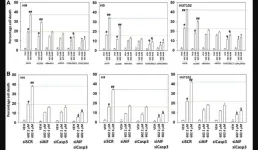(Press-News.org) A recent study from Baylor College of Medicine and Texas Children’s Hospital has discovered inhibitory and excitatory neurons play distinct roles in the pathogenesis of STXBP1 encephalopathy, one of the top five causes of pediatric epilepsies and among the most frequent causes of neurodevelopmental disorders. This early-onset disorder is caused by spontaneous mutations in the syntaxin-binding protein 1 (STXBP1) gene. While STXBP1 gene variants impair both excitatory and inhibitory neurotransmission, this study led by Dr. Mingshan Xue, associate professor at Baylor and principal investigator at the Jan and Dan Duncan Neurological Research Institute (Duncan NRI) finds its loss from GABAergic inhibitory neurons has a more critical impact on the pathogenesis of STXBP1 disorder. The paper was published in the Journal of Neuroscience.
By studying the affected cell types in greater detail and furthering our understanding of the underlying disease mechanisms, the study opens new opportunities to explore how the symptoms of this disorder can be modulated by specifically targeting these cell types and will aid in the development of targeted therapeutic interventions.
Reduced functional STXBP1 protein in neurons causes STXBP1 encephalopathy
STXBP1 protein plays an essential role in synaptic vesicle exocytosis – the fundamental process by which all neurotransmitters are released from nerve cells. There are two major classes of neurotransmitters - the excitatory (e.g. glutamatergic) and inhibitory (e.g. GABAergic) neurotransmitters. Neurons releasing excitatory and inhibitory neurotransmitters are extensively interconnected throughout the brain and they act together to regulate brain activity and function.
In patients with this disorder, mutations in the STXBP1 gene result in an insufficient amount of functional STXBP1 protein in neurons causing symptoms such as severe cognitive impairments and psychiatric symptoms such as autism, hyperactivity, anxiety, and aggression. About 90% of affected individuals also develop motor dysfunction and seizures that could begin in infancy or later in life.
To understand the individual functional contributions of excitatory or inhibitory neurons in the pathogenesis of this disorder, Dr. Xue and his team created mouse models in which the expression of the Stxbp1 gene was reduced to the levels seen in patients specifically in either glutamatergic or GABAergic neurons throughout major brain regions and studied its effect on epilepsy, cognitive, motor and psychiatric symptoms.
Loss of Stxbp1 in excitatory or inhibitory neurons has distinct outcomes
“Since STXBP1 impacts the release of both these neurotransmitters equally, we expected that its loss in either population would result in overlapping and equally severe symptoms,” Dr. Joo Hyun Kim, lead author of the study and a postdoctoral fellow in the Xue lab, said. “However, surprisingly, we found that reducing Stxbp1 in GABAergic neurons recapitulated a majority of the symptoms seen in Stxbp1 constitutive heterozygous knockout mice in which the expression of this gene is reduced in all neurons while inducing this mutation in glutamatergic neurons alone resulted in mice with fewer symptoms.”
Thus, this study indicates that a reduction in inhibitory transmission plays a more critical role in the pathogenesis of this disorder by contributing to symptoms such as early lethality, developmental delay, impaired nest building, hyperactivity, motor dysfunction, aggression, impaired contextual fear memory, myoclonic seizures, hindlimb clasping, and anxiety-like behaviors whereas reduction of excitatory neurotransmission causes a subset of symptoms such as anxiety, social aggression, and absence seizures.
“Our study is the first such comprehensive analysis of the individual contributions of excitatory and inhibitory neurons in STXBP1 disorder,” Dr. Xue said. “Our findings support the hypothesis that the impaired inhibitory neurotransmission is the primary disease mechanism in this disorder and offers researchers a new experimental framework to test the impact of modulators of both inhibitory and excitatory neurotransmitters to find customized treatments for each of these symptoms.”
-------------------------------------------------------------------------------------------------------------------------------
Others involved in the study were Wu Chen, Eugene S. Chao, Armando Rivera, Heet Naresh Kaku,
Kevin Jiang, Dongwon Lee, Hongmei Chen, Jaimie M. Vega, Teresa V. Chin, Kevin Jin, Kelly T. Nguyen, Sheldon S. Zou, Zain Moin and Shawn Nguyen. Their institutional affiliations can be found here. The study was supported in part by Citizens United for Research in Epilepsy (CURE Epilepsy Award), grants from the National Institute of Neurological Disorders, the National Institute of Mental Health, the Eunice Kennedy Shriver National Institute of Child Health and Human Development to Baylor College of Medicine Intellectual and Developmental Disabilities Research Center, Neurovisualization Core and Neurobehavioral Core as well as endowments to Dr. Mingshan Xue as a Caroline DeLuca Scholar.
END
Dissecting the roles for excitatory and inhibitory neurons in STXBP1 encephalopathy
2024-02-26
ELSE PRESS RELEASES FROM THIS DATE:
Boston College biologist awarded $2.5-million NIH grant to explore the role of viral insulins and potential applications to cancers
2024-02-26
Chestnut Hill, Mass (2/26/2024) – Boston College Assistant Professor of Biology Emrah Altindis has been awarded a five-year, $2.5-million grant from the National Institutes of Health to study viral insulins and mechanisms related to IGF-1 receptor protein inhibition and its potential applications in cancer treatment.
Altindis said he and the researchers in his lab will use the grant to learn more about how to use specific viral insulins – particularly insulin-like growth factor-1 (IGF-1) – to inhibit IGF-1 receptor action, which is increased in a range ...
New clinical practice guideline provides evidence-based recommendations for immunotherapy for inhalant allergy
2024-02-26
ALEXANDRIA, VA —The American Academy of Otolaryngology–Head and Neck Surgery Foundation published the Clinical Practice Guideline: Immunotherapy for Inhalant Allergy today in Otolaryngology–Head and Neck Surgery. This clinical practice guideline identifies quality improvement opportunities and provides clinicians trustworthy, evidence-based recommendations on the management of inhalant allergies with immunotherapy, supporting them to provide enhanced care to patients aged 5 years and older who are experiencing symptoms from inhalant allergies.
“More ...
SFU-led research team designs a cutting-edge protein lawnmower
2024-02-26
An SFU-led collaboration has designed the first synthetic protein-based motor which harnesses biological reactions to fuel and propel itself.
“Imagine if a Roomba could be powered only by the dirt it picks up,” says SFU Physics professor Nancy Forde, one of the authors of the study.
The team’s paper, led by SFU Physics PhD graduate Chapin Korosec and published today in Nature Communications, describes a protein-based molecular motor called “The Lawnmower,” which has been designed to cut a lawn of peptide “grass.” ...
Metal in glitter impairs aquatic plant growth, study shows
2024-02-26
Glitter is used in a wide array of colors and shapes in apparel, footwear, cosmetics, makeup, handbags, festive decorations, arts and crafts, and jewelry, among many other applications. During the Carnival holidays, hundreds of thousands of Brazilians cover parts of their bodies with it while dancing in the streets. Its brilliance is dazzling but it is considered an emerging pollutant by many scientists: like other microplastics (small plastic pieces less than 5 mm long), it is not filtered by wastewater treatment plants and ends up in rivers and the sea, interfering with aquatic life in various ways.
A study conducted at the Federal University of ...
Scientists assemble a richer picture of the plight and resilience of the foothill yellow-legged frog
2024-02-26
(Santa Barbara, Calif.) — Up to only a few inches in length, with a lemon-hued belly, the foothill yellow-legged frog may seem unassuming. But its range once stretched from central Oregon to Baja California. In 2023, it was listed under the federal Endangered Species Act. Its rapidly decreasing range is due in part to a fungal pathogen called Batrachochytrium dendrobatidis, or Bd, that has devastated amphibians around the world.
A team of researchers, including UC Santa Barbara’s Andrea Adams, has conducted the most comprehensive study to date ...
Neuropsychiatric symptoms predict which patients with mild cognitive impairment develop Alzheimer’s disease.
2024-02-26
As the years add up, it's common to notice slight changes in our ability to remember and think. Older people who have more marked changes than their peers can be diagnosed with mild cognitive impairment (MCI). Currently, we can’t easily predict which of these patients will develop Alzheimer’s disease and which will not.
“It's hard to predict which patients will have a more rapid progression and receive a diagnosis of dementia,” said Maria Vittoria Spampinato, M.D., division director of Neuroradiology at the Medical University of South Carolina.
“It’s important ...
Resurrecting niobium for quantum science
2024-02-26
For years, niobium was considered an underperformer when it came to superconducting qubits. Now scientists supported by Q-NEXT have found a way to engineer a high-performing niobium-based qubit and so take advantage of niobium’s superior qualities.
When it comes to quantum technology, niobium is making a comeback.
For the past 15 years, niobium has been sitting on the bench after experiencing a few mediocre at-bats as a core qubit material.
Qubits are the fundamental components of quantum devices. One qubit type relies on superconductivity to process information.
Touted for its superior qualities as a superconductor, niobium was always a promising ...
Long-term data reveals SARS-CoV-2 infection and vaccine-induced antibody responses are long-lasting
2024-02-26
A long-term analysis conducted by leading microbiologists at the Icahn School of Medicine at Mount Sinai reveals that antibody responses induced by COVID-19 vaccines are long-lasting. The study results, published online in the journal Immunity on February 22, challenge the idea that mRNA-based vaccine immunity wanes quickly.
The emergence of SARS-CoV-2, the virus that causes COVID-19, in late 2019 sparked the global pandemic that is now in its fifth year. Vaccines that were developed at record speed have saved millions of lives. However, the emergence of SARS-CoV-2 variants and waning immunity have decreased ...
Shaping the future of phage therapy: The 7th World Conference on Targeting Phage Therapy in Malta aims to transform clinical trials through translational research
2024-02-26
The 7th World Conference on Targeting Phage Therapy 2024, two-day event dedicated to advancing the field of phage research and therapy will be hosted at Corinthia Palace Malta on June 20-21.
Robert T. Schooley, M.D., Professor of Medicine at the University of California, San Diego, Co-Director of the Center for Innovative Phage Applications and Therapeutics, and member of the Executive Committee for the University of California Disaster Resilience Network, will introduce the messages and strategies behind phages therapy 2024.
His talk titled “Phage Therapeutics 2024: Essential Translational Research Components for ...
GZ17-6.02 with bexarotene kills mycosis fungoides cells
2024-02-26
“The present studies were performed to extend our knowledge of GZ17-6.02 biology from that known in solid tumor cell types such as prostate cancer cells to liquid tumor cell types, for example, mycosis fungoides.”
BUFFALO, NY- February 26, 2024 – A new research paper was published in Oncotarget's Volume 15 on February 8, 2024, entitled, “GZ17-6.02 interacts with bexarotene to kill mycosis fungoides cells.”
In this new study, researchers Michael R. Booth, Laurence Booth, Jane L. Roberts, Cameron West, and Paul Dent from Virginia Commonwealth University and Genzada Pharmaceuticals investigated the therapeutic agent GZ17-6.02, composed of curcumin, ...






